share March 22, 2009
Distributed Control of Robotic Networks
A Mathematical Approach to Motion Coordination Algorithms
Francesco Bullo
Jorge Cort´es
Sonia Mart´ınez
�
share March 22, 2009
Copyright c 2006-2009 by F. Bullo, J. Cort´es, and S. Mart´ınez
This document is a complete free online version of the following book.
Distributed Control of Robotic Networks, by Francesco Bullo,
Jorge Cort´es and Sonia Mart´ınez, Applied Mathematics Series,
Princeton University Press, 2009, ISBN 978-0-691-14195-4.
The book is available online at
http://coordinationbook.info
(i) You are allowed to freely download, share, print, or photocopy this
document.
(ii) You are not allowed to modify, sell, or claim authorship of any part
of this document.
(iii) We thank you for any feedback information, including suggestions,
evaluations, error descriptions, or comments about teaching or re-
search uses.
�
share March 22, 2009
To Lily, to Sonia, and to Olimpia and Leonardo
�
share March 22, 2009
Contents
Preface
Chapter 1. An introduction to distributed algorithms
1.1
1.2
1.3
1.4
1.5
1.6
1.7
1.8
1.9
Elementary concepts and notation
Matrix theory
Dynamical systems and stability theory
Graph theory
Distributed algorithms on synchronous networks
Linear distributed algorithms
Notes
Proofs
Exercises
Chapter 2. Geometric models and optimization
2.1
2.2
2.3
2.4
2.5
2.6
Basic geometric notions
Proximity graphs
Geometric optimization problems and multicenter functions
Notes
Proofs
Exercises
Chapter 3. Robotic network models and complexity notions
3.1
3.2
3.3
3.4
3.5
3.6
3.7
A model for synchronous robotic networks
Robotic networks with relative sensing
Coordination tasks and complexity notions
Complexity of direction agreement and equidistance
Notes
Proofs
Exercises
Chapter 4. Connectivity maintenance and rendezvous
4.1
4.2
Problem statement
Connectivity maintenance algorithms
vi
1
1
6
12
20
37
52
66
68
84
93
93
102
109
122
123
131
136
136
148
155
162
163
165
172
175
176
178
�
DCRN March 22, 2009
4.3
4.4
4.5
4.6
4.7
Rendezvous algorithms
Simulation results
Notes
Proofs
Exercises
Chapter 5. Deployment
5.1
5.2
5.3
5.4
5.5
5.6
Problem statement
Deployment algorithms
Simulation results
Notes
Proofs
Exercises
Chapter 6. Boundary estimation and tracking
6.1
6.2
6.3
6.4
6.5
6.6
6.7
Event-driven asynchronous robotic networks
Problem statement
Estimate update and cyclic balancing law
Simulation results
Notes
Proofs
Exercises
Bibliography
Algorithm Index
Subject Index
Symbol Index
187
196
197
199
211
214
215
217
228
232
233
240
242
243
247
251
261
263
265
270
273
299
300
306
v
“Distributed Control of Robotic Networks” by F. Bullo, J. Cort´es and S. Mart´ınez
Copyright c 2006-2009. Manuscript under contract. This version: March 22, 2009
�
share March 22, 2009
Preface
OBJECTIVES
Recent years have witnessed a thriving research activity on cooperative con-
trol and motion coordination. This interest is motivated by the growing
possibilities enabled by robotic networks in the monitoring of natural phe-
nomena and the enhancement of human capabilities in hazardous and un-
known environments.
Our first objective in this book is to present a coherent introduction to
basic distributed algorithms for robotic networks. This emerging discipline
sits at the intersection of different areas such as distributed algorithms, par-
allel processing, control, and estimation. Our second objective is to provide
a self-contained, broad exposition of the notions and tools from these areas
that are relevant in cooperative control problems. These concepts include
graph-theoretic notions (connectivity, adjacency, and Laplacian matrices),
distributed algorithms from computer science (leader election, basic tree
computations) and from parallel processing (averaging algorithms, conver-
gence rates), and geometric models and optimization (Voronoi partitions,
proximity graphs). Our third objective is to put forth a model for robotic
networks that helps to rigorously formalize coordination algorithms running
on them. We illustrate how computational geometry plays an important role
in modeling the interconnection topology of robotic networks. We draw on
classical notions from distributed algorithms to provide complexity measures
that characterize the execution of coordination algorithms. Such measures
allow us to quantify the algorithm performance and implementation costs.
Our fourth and last objective is to present various algorithms for coordina-
tion tasks such as connectivity maintenance, rendezvous, and deployment.
We especially emphasize the analysis of the correctness and of the complex-
ity of the proposed algorithms. The technical treatment combines control-
theoretic tools such as Lyapunov functions and invariance principles with
techniques from computer science and parallel processing, such as induction
and message counting.
�
DCRN March 22, 2009
THE INTENDED AUDIENCE
The intended audience for this book consists of first- and second-year grad-
uate students in control and robotics from Computer Science, Electrical
Engineering, Mechanical Engineering, and Aerospace Engineering. A famil-
iarity with basic concepts from analysis, linear algebra, dynamical systems,
and control theory is assumed. The writing style is mathematical: we have
aimed at being precise in the introduction of the notions, the statement of
the results, and the formal description of the algorithms. This mathematical
style is complemented by numerous examples, exercises, intuitive explana-
tions and motivating discussions for the introduction of novel concepts.
Researchers in the fields of control theory and robotics who are not aware
of the literature on distributed algorithms will also benefit from the book.
The book uses notions with a clear computer-science flavor such as syn-
chronous networks, complexity measures, basic tree computations, and lin-
ear distributed iterations, and integrates them into the study of robotic
networks. Likewise, researchers in the fields of distributed algorithms and
automata theory who are not aware of robotic networks and distributed con-
trol will also find the book useful. The numerous connections that can be
drawn between the classical study of distributed algorithms and the present
book provide a friendly roadmap with which to step into the field of con-
trolled coordination of robotic networks.
AN OUTLINE OF THE BOOK
Chapter 1 presents a broad introduction to distributed algorithms on syn-
chronous networks. We start by presenting basic matrix notions and a
primer on graph theory that gives special emphasis to linear algebraic as-
pects such as adjacency and Laplacian matrices. After this, we introduce
the notion of synchronous networks, and we present time, communication,
and space complexity notions. We examine these notions in basic algorithms
such as broadcast, tree computation, and leader election. The chapter ends
with a thorough treatment of linear iterations and averaging algorithms.
Chapter 2 presents basic geometric notions that are relevant in motion co-
ordination. Robotic networks have a spatial component which is not always
present in synchronous networks as studied in computer science. Geometric
objects such as polytopes, Voronoi partitions, and geometric centers play
an important role in modeling the interaction of robotic networks with the
physical environment. Proximity graphs allow us to rigorously formalize the
interconnection topology of a network of robotic agents, and characterize
the spatially distributed character of coordination algorithms. This notion
is a natural translation of the notion of distributed algorithms treated in
the previous chapter. The chapter concludes with a detailed discussion on
concepts from geometric optimization and multicenter functions.
vii
“Distributed Control of Robotic Networks” by F. Bullo, J. Cort´es and S. Mart´ınez
Copyright c 2006-2009. Manuscript under contract. This version: March 22, 2009
�
DCRN March 22, 2009
Chapter 3 introduces a model for a group of robots that synchronously
communicate/sense locally, process information, and move. We describe
the physical components of the robotic network and we introduce a formal
notion of a motion coordination algorithm as a control and communication
law. Generalizing the notions introduced in Chapter 1, we introduce the
notions of task and of time, communication, and space complexity. We
illustrate these concepts by means of a simple and insightful example of a
group of robots moving on a circle.
Chapter 4 analyzes in detail two coordination tasks: connectivity main-
tenance and rendezvous. The objective of “connectivity maintenance” is to
establish local rules that allow agents to move without losing the connec-
tivity of the overall networks. The objective of “rendezvous” is to establish
local rules that allow agents to agree on a common spatial location. We
present coordination algorithms that achieve these tasks, making use of the
geometric concepts introduced in the previous chapters. Furthermore, we
provide results on the correctness and complexity of these algorithms.
Chapter 5 considers deployment problems. The objective of “deployment”
is to establish local rules that allow agents to achieve optimal network config-
urations in an environment of interest. Here, optimality is defined using the
multicenter functions from geometric optimization introduced in Chapter 2.
We present coordination algorithms that achieve these tasks, characterizing
their correctness and complexity.
Chapter 6 has a dual purpose. First, we introduce an event-driven control
and communication law, in which computation and communication actions
are triggered by asynchronous events, rather than taking place on a periodic
schedule. Second, we consider a boundary tracking problem, and propose
an “estimation and balancing” algorithm that allows a robotic network to
monitor a moving boundary efficiently.
The reader will note that, as the discussion progresses, the selection of
topics emphasizes problems in which we have been directly involved. There
are exciting topics that have been considered in the literature and are not
presented here in depth, albeit we briefly discuss a number of them through-
out the exposition. In this, our first effort, we decided to tackle the problems
that we knew better, postponing the rest for the future. We hope the reader
will appreciate the result and share, while reading it, some of the fun we
had in writing it.
HOW TO USE THIS BOOK AS A TEXT
Our experience and opinion is that this text can be used for a quarter- or
semester-long course on “Distributed Control” or on “Robotic Networks.”
Such a course could be taught in an Engineering or a Computer Science
department. We taught such a course at our respective institutions over a
viii
“Distributed Control of Robotic Networks” by F. Bullo, J. Cort´es and S. Mart´ınez
Copyright c 2006-2009. Manuscript under contract. This version: March 22, 2009
�
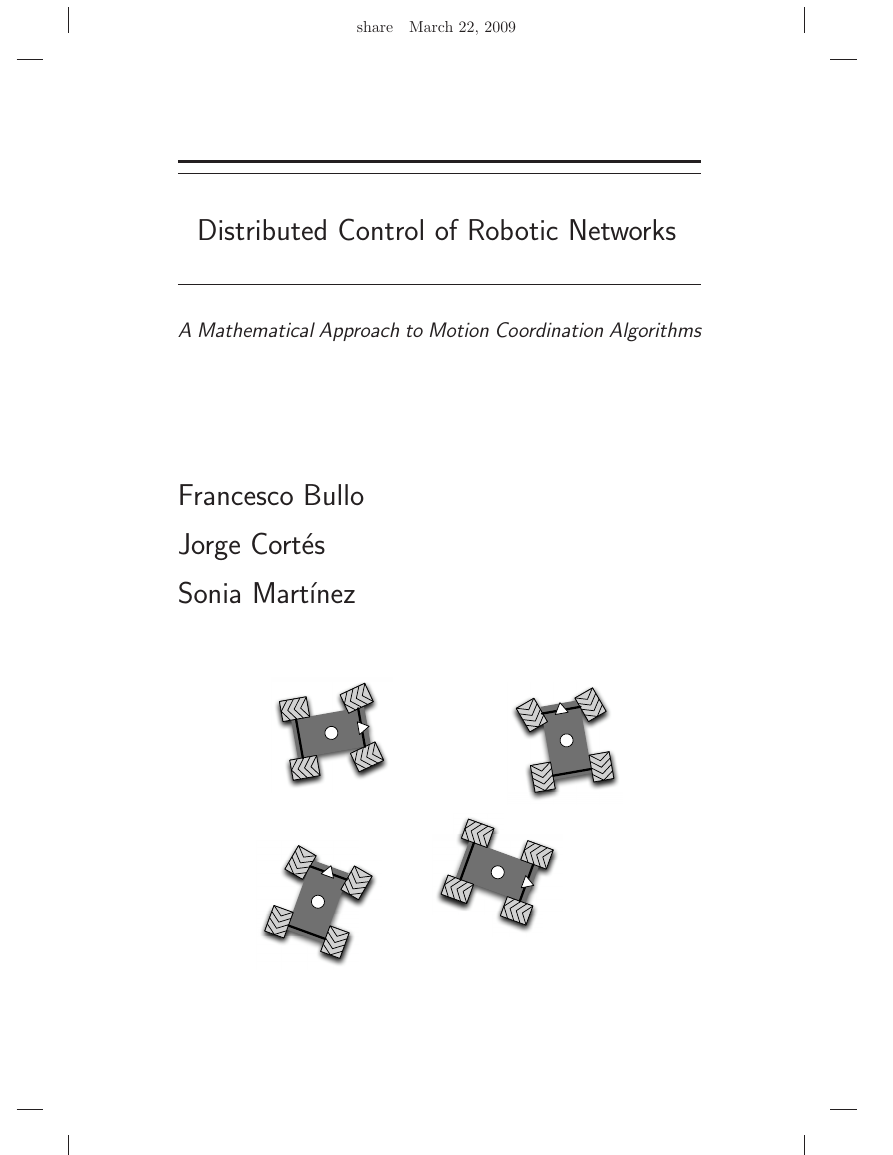
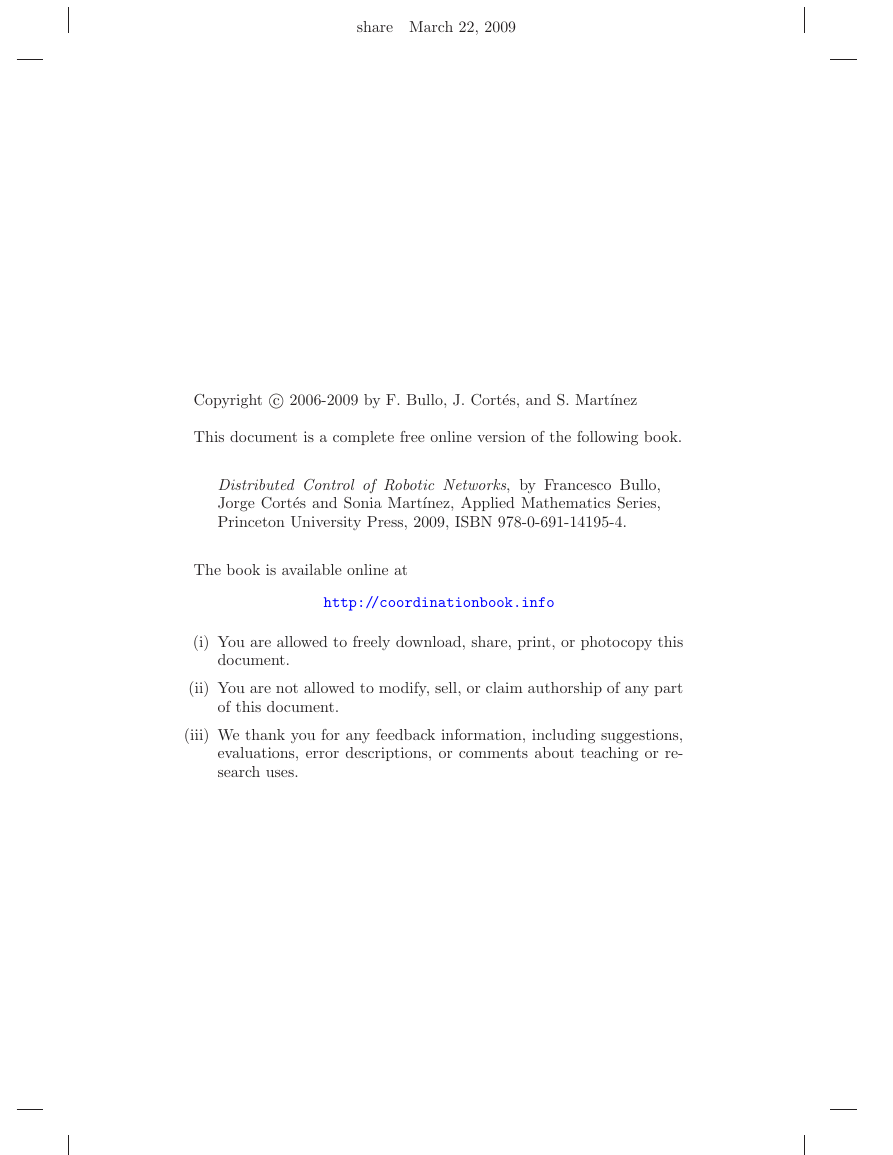

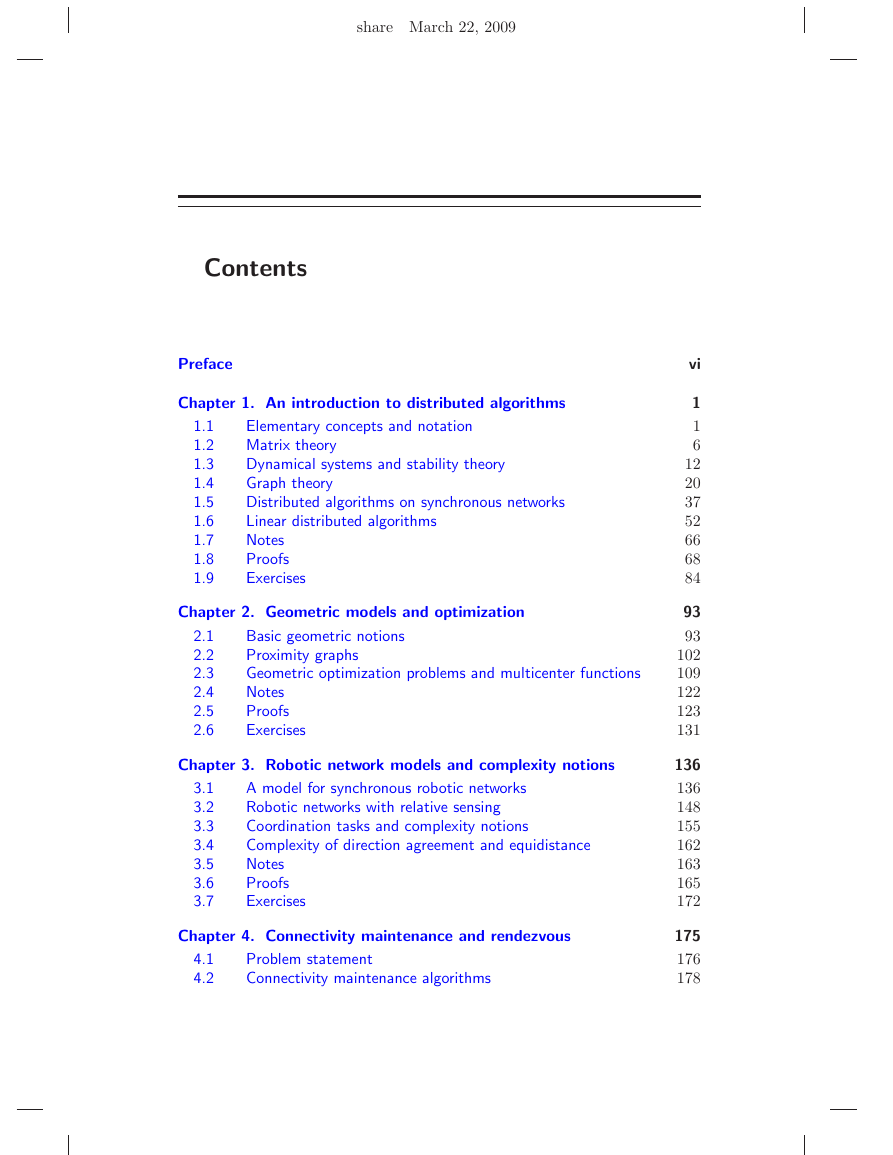
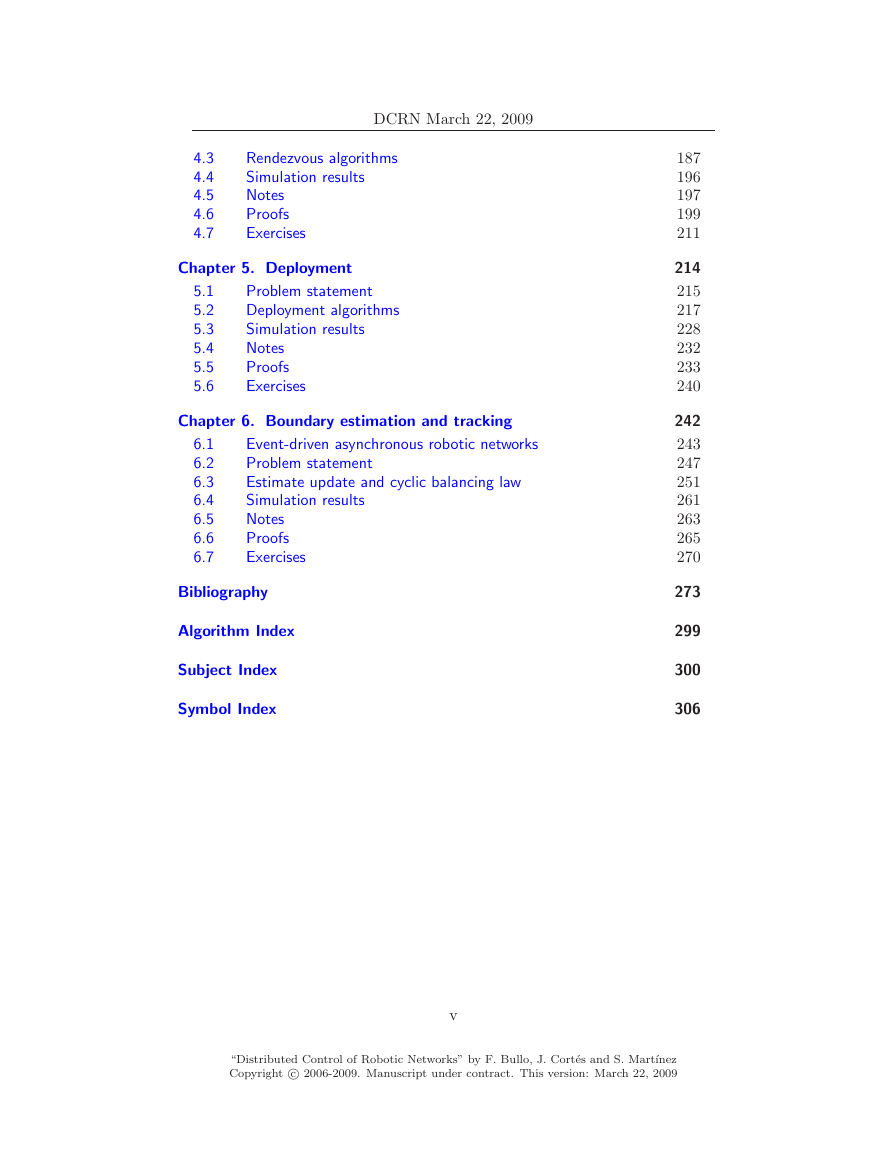
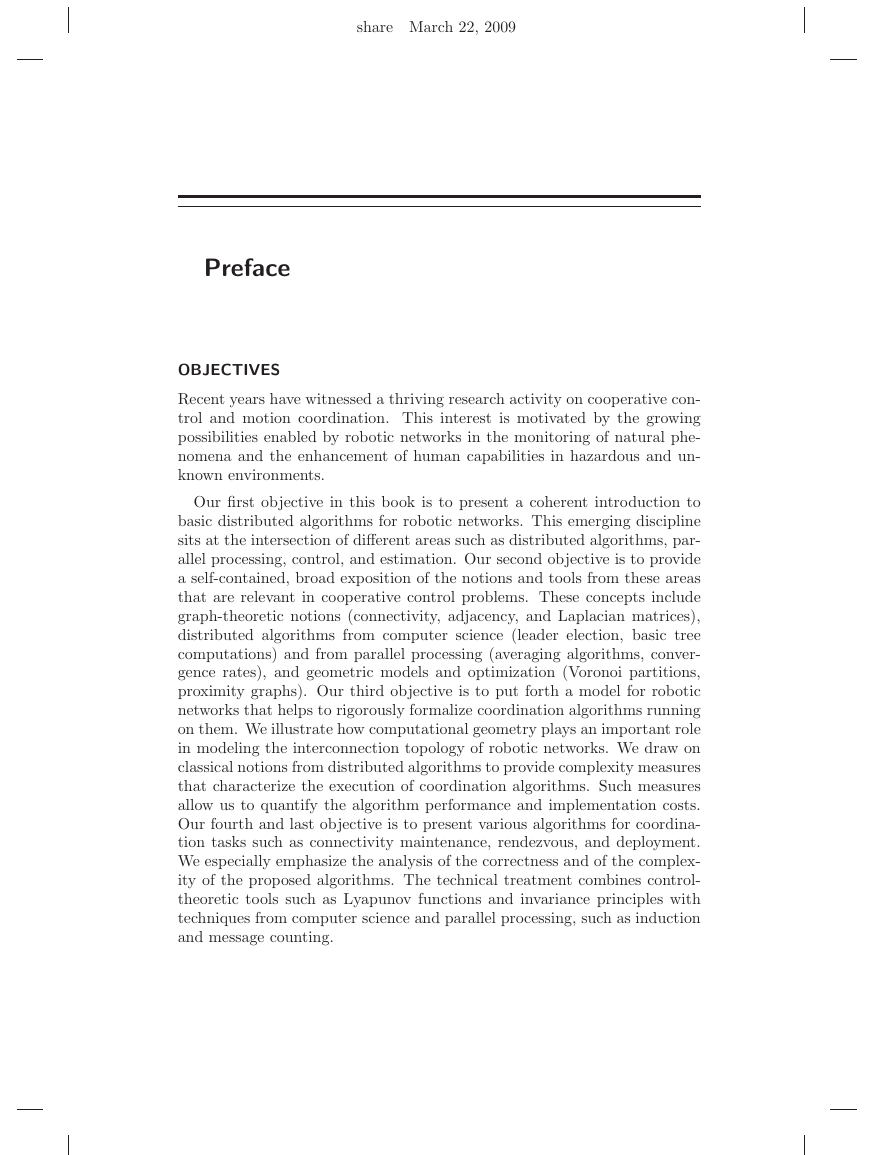

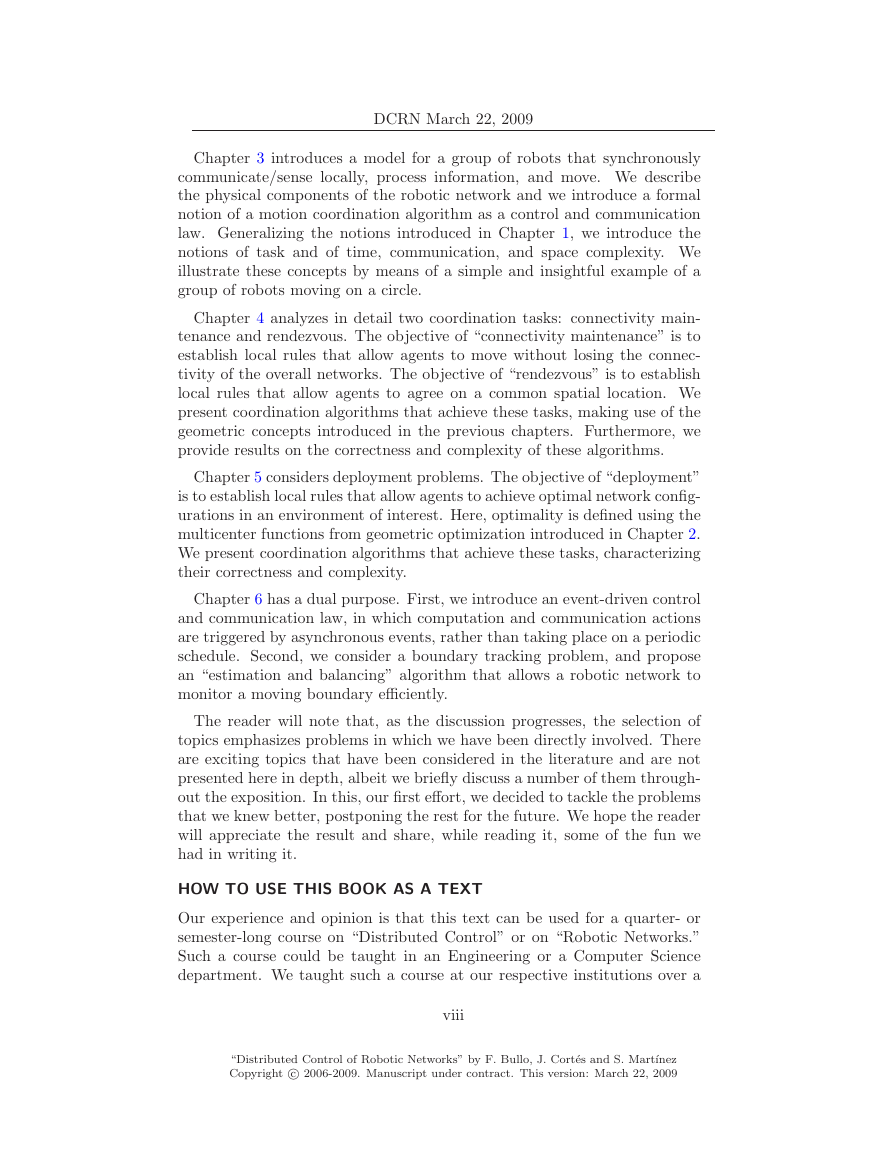








 2023年江西萍乡中考道德与法治真题及答案.doc
2023年江西萍乡中考道德与法治真题及答案.doc 2012年重庆南川中考生物真题及答案.doc
2012年重庆南川中考生物真题及答案.doc 2013年江西师范大学地理学综合及文艺理论基础考研真题.doc
2013年江西师范大学地理学综合及文艺理论基础考研真题.doc 2020年四川甘孜小升初语文真题及答案I卷.doc
2020年四川甘孜小升初语文真题及答案I卷.doc 2020年注册岩土工程师专业基础考试真题及答案.doc
2020年注册岩土工程师专业基础考试真题及答案.doc 2023-2024学年福建省厦门市九年级上学期数学月考试题及答案.doc
2023-2024学年福建省厦门市九年级上学期数学月考试题及答案.doc 2021-2022学年辽宁省沈阳市大东区九年级上学期语文期末试题及答案.doc
2021-2022学年辽宁省沈阳市大东区九年级上学期语文期末试题及答案.doc 2022-2023学年北京东城区初三第一学期物理期末试卷及答案.doc
2022-2023学年北京东城区初三第一学期物理期末试卷及答案.doc 2018上半年江西教师资格初中地理学科知识与教学能力真题及答案.doc
2018上半年江西教师资格初中地理学科知识与教学能力真题及答案.doc 2012年河北国家公务员申论考试真题及答案-省级.doc
2012年河北国家公务员申论考试真题及答案-省级.doc 2020-2021学年江苏省扬州市江都区邵樊片九年级上学期数学第一次质量检测试题及答案.doc
2020-2021学年江苏省扬州市江都区邵樊片九年级上学期数学第一次质量检测试题及答案.doc 2022下半年黑龙江教师资格证中学综合素质真题及答案.doc
2022下半年黑龙江教师资格证中学综合素质真题及答案.doc